 Open Access
Open Access
ARTICLE
A Fault-Tolerant Mobility-Aware Caching Method in Edge Computing
1 School of Computer Information Engineering, Jiangxi Normal University, Nanchang, 330000, China
2 School of Digital Industry, Jiangxi Normal University, Shangrao, 334000, China
3 The College of Computer Science, Chongqing University, Chongqing, 400044, China
4 College of Mechanical and Vehicle Engineering, Chongqing University, Chongqing, 400030, China
5 School of Computer and Software Engineering, Xihua University, Chengdu, 610039, China
6 Electric Power Research Institute of State Grid Ningxia Electric Power Company Ltd., Yinchuan, 750002, China
7 College of Computer and Information Science, Chongqing Normal University, Chongqing, 401331, China
* Corresponding Authors: Kunyin Guo. Email: ; Yunni Xia. Email:
(This article belongs to the Special Issue: Machine Learning Empowered Distributed Computing: Advance in Architecture, Theory and Practice)
Computer Modeling in Engineering & Sciences 2024, 140(1), 907-927. https://doi.org/10.32604/cmes.2024.048759
Received 17 December 2023; Accepted 06 February 2024; Issue published 16 April 2024
Abstract
Mobile Edge Computing (MEC) is a technology designed for the on-demand provisioning of computing and storage services, strategically positioned close to users. In the MEC environment, frequently accessed content can be deployed and cached on edge servers to optimize the efficiency of content delivery, ultimately enhancing the quality of the user experience. However, due to the typical placement of edge devices and nodes at the network’s periphery, these components may face various potential fault tolerance challenges, including network instability, device failures, and resource constraints. Considering the dynamic nature of MEC, making high-quality content caching decisions for real-time mobile applications, especially those sensitive to latency, by effectively utilizing mobility information, continues to be a significant challenge. In response to this challenge, this paper introduces FT-MAACC, a mobility-aware caching solution grounded in multi-agent deep reinforcement learning and equipped with fault tolerance mechanisms. This approach comprehensively integrates content adaptivity algorithms to evaluate the priority of highly user-adaptive cached content. Furthermore, it relies on collaborative caching strategies based on multi-agent deep reinforcement learning models and establishes a fault-tolerance model to ensure the system’s reliability, availability, and persistence. Empirical results unequivocally demonstrate that FT-MAACC outperforms its peer methods in cache hit rates and transmission latency.Keywords
With the exponential growth of data traffic generated by Internet of Things (IoT) devices, existing networks and infrastructure are facing significant challenges [1]. The traditional cloud-based model is increasingly proving to be inadequate, with its lack of agility and efficiency becoming particularly evident in the face of growing demands and data loads. In conventional cloud computing systems, data must traverse the Internet to reach cloud servers for processing, leading to significant latency issues, which are intolerable for real-time applications [2]. To overcome these limitations, Mobile Edge Computing (MEC) technology has emerged [3], enabling the caching of resources at the network edge and providing computing and storage services close to the requests. This enhances the responsiveness of latency-sensitive applications and ensures users experience rapid system responses. However, due to its reliance on unreliable wireless communication and distributed resource infrastructure, applications based on MEC are more susceptible to various types of system failures or faults, including MEC overload and software or hardware failures, all of which further contribute to a poor Quality of Experience (QoE) perceived by users [4].
Despite the numerous benefits of edge computing, its highly distributed and dynamic nature, coupled with the diversity of user preferences, service requests, and mobility patterns, make ensuring high cache utilization and user satisfaction through effective fault tolerance mechanisms a complex and challenging task. To address this challenge and ensure reliable and seamless content delivery to users, several key issues need to be addressed:
(i) Edge servers have limited capacity and cannot cache all the content that users might request.
(ii) Edge servers must provide collaborative services with both caching and communication functions, rather than building isolated services for individual users.
(iii) Accurately predicting user preferences, considering the differences in content preferences among individuals, is essential.
(iv) The caching mechanism should align with user mobility, ensuring that the requests of mobile users are met with guaranteed service efficiency.
(v) Edge nodes are susceptible to malicious activities, physical damage in harsh environments, or temporary disruptions in network connectivity when frequently exchanging tasks, which can impact real-time data communication.
As a response, we introduce a mobile-aware caching approach that integrates fault tolerance mechanisms. This paper primarily focuses on caching strategies aimed at reducing latency and enhancing cache hit rates and proposes a fault tolerance mechanism to optimize the performance of MEC systems, ultimately improving user experience and system efficiency. Through extensive large-scale simulation experiments, we have validated the superior performance and effectiveness of the FT-MAACC method compared to conventional approaches.
The remaining part of this paper is organized as follows: a summary of related work is provided in Section 2. The system model and problem formulation are presented in Section 3. Section 4 discusses the proposed primary methods. Simulation results will be discussed in Section 5. Finally, closing remarks and prospects are provided in Section 6.
In recent years, with the advancement of MEC, content caching technology has garnered significant international research interest as an effective solution for reducing data traffic. This technology reduces latency and network congestion by enabling servers to quickly fulfill user requests through the local storage of popular content. Consequently, the research community has developed numerous MEC caching strategies. For example, Reiss-Mirzaei et al. [5] considered the social and behavioral characteristics of users that affect caching strategies and proposed an edge caching mechanism based on social relationships and user behavior characteristics, aimed at reducing network traffic and latency in accessing popular content. Zhang et al. [6] developed a collaborative edge caching framework that integrates intelligent vehicles for multimedia services in modern wireless networks, enhancing mobile edge computing resource utilization. Ndikumana et al. [7] addressed mobile network latency issues and proposed collaborative cache allocation and computation offloading strategies to maximize resource utilization.
In the context of enhancing network performance and user satisfaction, personalized caching and mobility-aware MEC caching have garnered significant attention. These approaches are crucial in meeting user requirements, optimizing network efficiency, and providing personalized services and content recommendations. Tang et al. [8] addressed the efficient use of edge computing and IoT devices for caching multimedia content in Information-Centric Networks, proposing a solution integrating machine learning-based location prediction, intelligent caching, and optimized caching replacement algorithms. Wu et al. [9] explored collaborative caching in Vehicle Edge Computing (VEC), using asynchronous joint learning and deep reinforcement learning to optimize caching locations and improve the global model’s accuracy. Wei et al. [10] introduced user destination prediction with trajectory information, integrated with a caching decision algorithm for creating efficient cache deployment plans. Given the scale and complexity of MEC caching, deep reinforcement learning algorithms, like Q-learning [11], have shown significant potential in optimizing these problems. Jiang et al. [12] delved into collaborative content caching in MEC, proposing a reinforcement learning-based architecture and a Multi-Agent Reinforcement Learning (MARL) algorithm to manage content caching, particularly for unknown user preferences inferred from historical demand patterns.
Although multi-agent deep reinforcement learning has its advantages, utilizing the shared experiences among agents to improve learning efficiency, it also has limitations, mainly due to insufficient consideration of user mobility characteristics. As Ostrowski et al. [13] proposed, in dynamic network environments, mobile fog nodes and end users exhibit time-varying characteristics, including dynamic network topology changes, which pose additional challenges to the effectiveness and applicability of deep reinforcement learning algorithms. In contrast, Zhong et al. [14] proposed a system model encompassing both centralized and decentralized caching systems, introducing a deep learning-based Actor-Critic framework to optimize content delivery latency. Their model, however, is static, differing from the dynamic approach in this paper. Additionally, Song et al. [15] focused on static users within MEC environments, using a single-agent learning mechanism to optimize collaborative caching models. Single-agent deep reinforcement learning focuses on individual learning in isolated environments, not fully exploiting the collaborative potential among multiple agents, which is a key focus of multi-agent deep reinforcement learning in this study.
In the distributed and heterogeneous environment of edge computing, where numerous edge nodes and devices are present, risks such as hardware malfunctions, network disruptions, or power outages are common. Given the inevitability of failures in this environment, fault tolerance becomes a crucial aspect. Consequently, researchers have developed various strategies to address this challenge. For instance, Zhang et al. [16] introduced an online offloading framework utilizing multi-step reinforcement learning, featuring fault detection, recovery strategies, backup-based fault recovery, and checkpoint techniques. Sun et al. [17] proposed a fault-tolerant Quality of Service (QoS)-aware scheduling model for mixed-edge-cloud environments, evolving the traditional Primary-Backup (PB) model into a reliability-oriented time-constrained approach. Concurrently, Mitsis et al. [18] presented a multi-user-multi-server-multi-access edge computing operational framework based on prospect theory, game theory, and reinforcement learning principles. Their framework focuses on enabling MEC servers to determine their optimal published prices in a semi-autonomous and fully autonomous manner, marking a significant advancement in our research field. However, compared to our proposed FT-MAACC, Mitsis et al.’s study primarily concentrates on pricing strategies and behavioral awareness, while our work is more focused on integrating content adaptability algorithms, collaborative caching strategies, and fault tolerance models to address fault tolerance challenges in the MEC environment.
Our approach combines a multi-agent deep reinforcement learning (DRL) model with collaborative caching strategies, integrating fault tolerance mechanisms to address base station failures. In the dynamic landscape of distributed edge computing, where user and base station mobility frequently alter network conditions [19], a single-agent learning approach might struggle to keep pace with these changes. This is where the advantage of multiple DRL agents becomes evident. They independently explore and learn in diverse environments, effectively adapting to these shifts, meeting user demands more efficiently and enhancing overall network performance. Unlike single-agent methods, multi-agent DRL not only offers greater potential in adapting to such dynamic environments but also brings forth new challenges in cooperation and communication, which are vital for optimizing content caching and delivery processes. The integration of fault tolerance mechanisms concurrently plays a crucial role, in mitigating the effects of base station failures and ensuring the stability and reliability of the system.
3 System Model and Problem Formulation
In this section, we provide a detailed exposition of the system model and the formulation of the problem.
In this paper, we deploy an MEC environment where each base station is equipped with an edge server with a storage capacity denoted as

As illustrated in Fig. 1, the system architecture can be divided into three fundamental layers [21]. At the topmost tier is the cloud server layer, consisting of high-performance servers with ample storage capacity. The intermediate layer is the edge server layer, comprising various base stations, each equipped with data storage, caching capabilities, and computational resources. The bottom layer is composed of mobile vehicle users. These base stations are distributed randomly within the simulated area, interconnected through wireless networks, and linked to the cloud servers via backhaul connections. When a user initiates a content request, the request is initially transmitted to the nearby base station. The base station then searches its local cache for the requested content. If the content is available in the local cache, the base station promptly delivers it to the mobile user. In cases where the desired content is not found in the local cache, the base station attempts to request the content from neighboring base stations. Only if adjacent base stations cannot provide the requested content does the base station forward the request to the cloud center [22].

Figure 1: Edge computing system model
Edge servers face limitations related to storage capacity and computational resources, which necessitate the selective caching of content to ensure quality of service for users [23]. At
where, the binary variable
Considering the constraints imposed by hardware resources and storage capacity, the cache capacity of edge servers should not exceed their total available space. Hence, edge servers must adhere to Eq. (3). This implies that, at
where,
Transmission delay refers to the time delay experienced by data during its transfer across a network. This delay can be categorized into three primary components: firstly, the delay associated with data transmission within local caches; secondly, the delay arising from collaborative transfers between various edge servers; and lastly, the delay incurred when data is transmitted from the cloud to end users. These three components collaboratively contribute to the reduction of the overall transmission delay [24]. In
where,
The total transmission delay is defined as:
In this assumption, we consider that the mobility of a mobile user exhibits an arbitrary pattern, with the direction and angle of movement varying over time. This implies that the user’s movement trajectory is not constrained to a specific pattern or path and can change dynamically based on various factors or influences. Thus the user’s path is expressed in terms of latitude and longitude as follows:
The failure probability of edge servers is a multifaceted issue that is influenced by various factors. The failure probability is affected by multiple factors, such as the quality of hardware equipment, environmental conditions, operating time, and workload status [25]. This paper assumes that the failure events of edge servers are independent and follow a Poisson process. Consequently, the failure probability of an edge server equipped with base station
where X represents the number of failure occurrences,
The probability of task processing failure
where
When a base station fails, it ceases to accept user request tasks. However, if a failure occurs after receiving a user request, resulting in the inability to process the received task, it leads to a delay in task execution:
where
The content caching problem involves minimizing content delivery latency in scenarios that consider additional requirements or constraints. Our goal is to minimize latency to the greatest extent possible while meeting the time constraints and capacity limits of each MEC, all the while ensuring the effective delivery of the required content. Consequently, this problem is formally formulated as:
Constraint C1 indicates the size of the content requested by the user cannot exceed the capacity size of the edge server. Constraint C2 is to constrain the non-negativity and integrity of the variable. Constraint C3 indicates the maximum distance of the user request content. Constraint C4 states that the delay caused by a base station failure, leading to the inability to process an individual user request task, must be shorter than the time it takes for a user to successfully send a request to the base station.
To fulfill user requests and minimize content transmission latency, edge servers can proactively predict the content that users are likely to request and cache it locally. While highly popular content is more likely to be requested, it fails to account for users’ personal preferences [26]. Therefore, simply predicting based on popularity is not always realistic. In the context of users’ mobility, accurately predicting content that aligns with their preferences and caching the target content accordingly is a challenging problem that aims to further enhance the QoS for users. Based on this, we propose an adaptive content prediction algorithm (ACP) that takes into account user preferences. The specific algorithm is depicted in Algorithm 1.
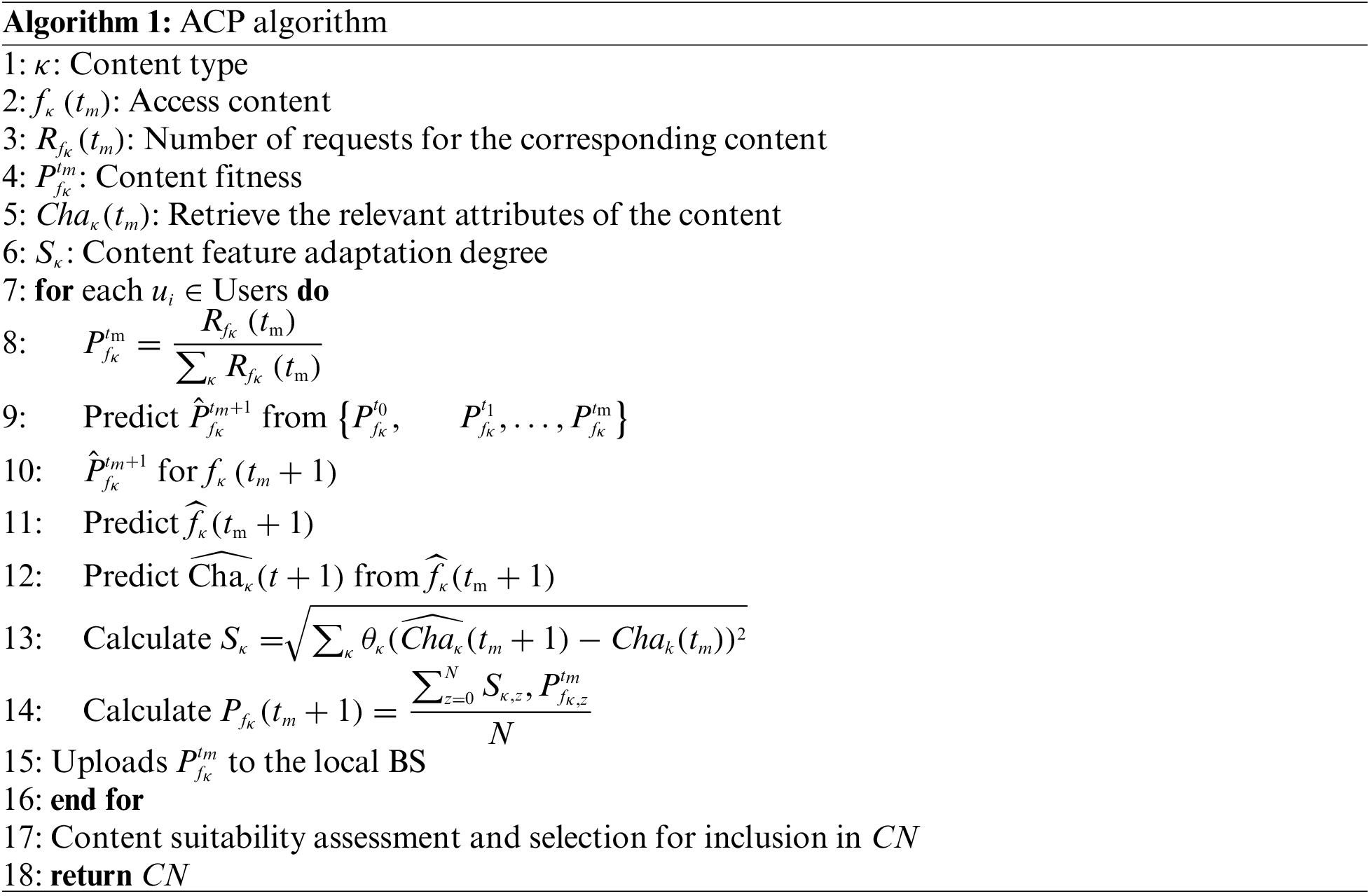
Initially, collect the historical records of user content access within time period T. The cumulative number of content accessed by users is denoted as W. Time period T is then divided into o time slots, denoted as
where,
The content feature adaptation degree
where
Based on the content feature matching, the content adaptation degree
where,
4.2 Multi-Agent Deep Reinforcement Learning Model
DRL is a technique that merges deep learning and reinforcement learning to train intelligent agents [27]. By engaging in ongoing interactions with the environment, these agents learn optimal strategies to make decisions. Multiple DRL agents refer to the presence of multiple independent intelligent agents simultaneously in a reinforcement learning environment [28]. In traditional reinforcement learning, typically only one agent interacts with the environment and learns the optimal strategy. The objective of multiple deep reinforcement learning agents is to learn and optimize their strategies through collaboration or competition, aiming to achieve global optimality or specific goals. Each agent perceives the environmental state, selects actions, and interacts with the environment, continuously improving its strategy through trial and error and learning [29].
In this paper, we use a multi-intelligent deep reinforcement learning framework (Fig. 2), and partially incomplete observable reinforcement learning problems can be modeled as Partially Observable Markov Decision Processes (POMDP) [30] modeled as a six-tuple

Figure 2: Schematic illustration of the Multi-Agent Actor-Critic framework
In this context,
1) State: at time
2) Action: The action set
3) Reward: The reward function
4.3 Fault-Tolerant Multi-Agent Actor-Critic Algorithm for Content Caching
Algorithm 2, referred to as
Understanding the computational complexity of
Beyond its architectural design,
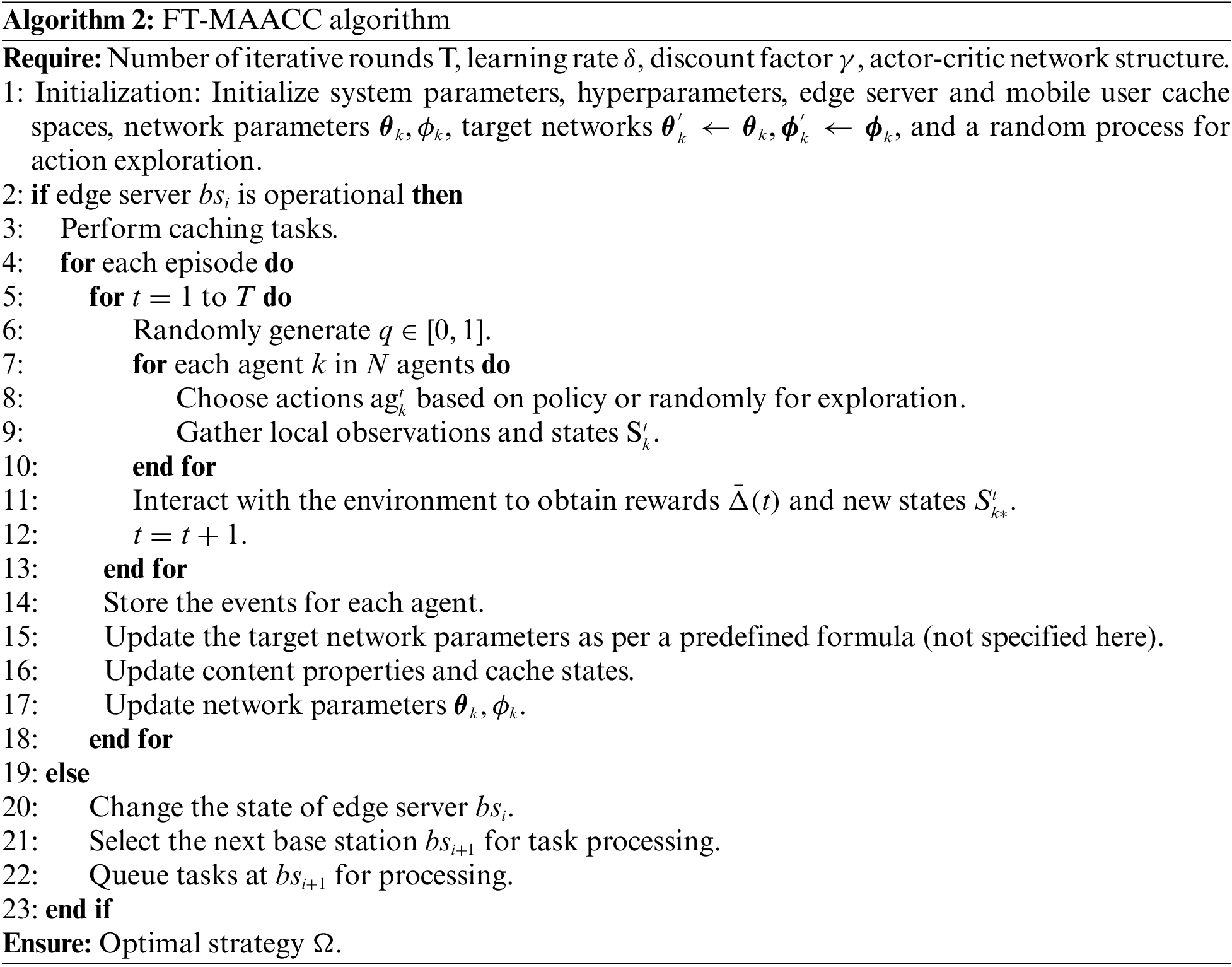
To assess the FT-MAACC method and simulate content requests and user behavior in mobile environments, we integrated mobile user access event logs and mobility trajectories from the Shanghai Telecom dataset [31] with user content preferences from the Movielens 1M [32]. The Shanghai dataset comprises over 7.2 million content access event records and their corresponding mobility trajectories from 9,481 mobile users across 3,233 edge sites over six months, reflecting users’ mobility patterns and behavioral habits. By incorporating rating information from the MovieLens dataset, we attributed specific content preferences to these mobility trajectories, simulating users’ interests in movies or video content at various locations and times. This approach enabled the construction of a comprehensive model that reflects both the realities of the mobile environment and user preferences. Fig. 3 shows the distribution location of edge nodes in Shanghai. Fig. 4 is an example recording the trajectory of a taxi in the city heart of Shanghai. We use Python to implement the proposed
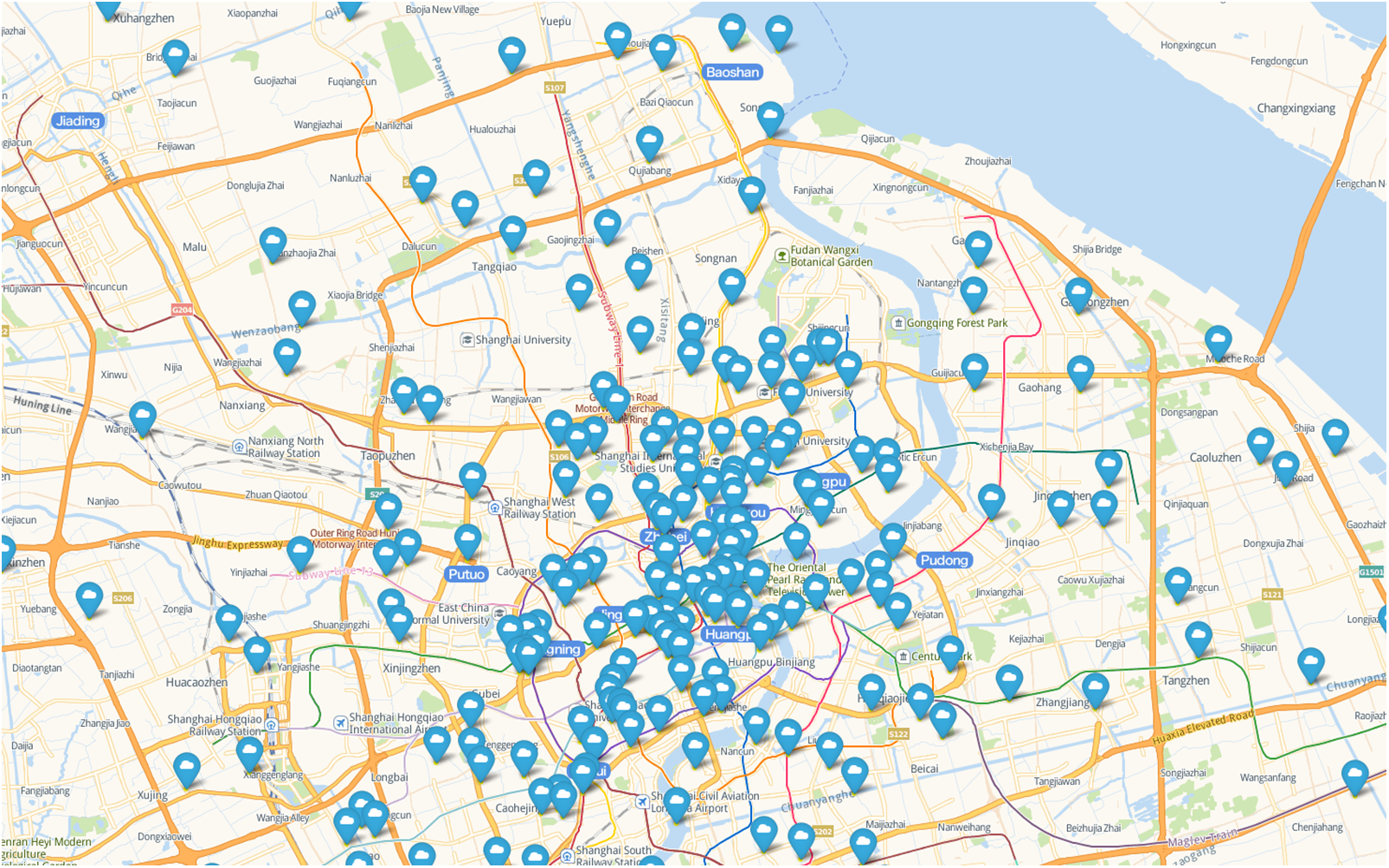
Figure 3: Blue coordinate icons represent each edge node in Shanghai’s downtown area showing the general distribution of the whole network

Figure 4: The green lines represent the route trajectory of a taxi in the city heart of Shanghai on a certain day

For performance analysis, we configured an environment where each base station was equipped with an edge server. Different base stations cached corresponding contents according to corresponding caching strategies to test the resource requests of mobile vehicles.
As shown in Fig. 5, different kinds of applications are represented by different shapes, such as triangles, prototypes, and squares. Different colors indicate the resources cached by different edge servers. When the vehicle moves, the resource hit rates of
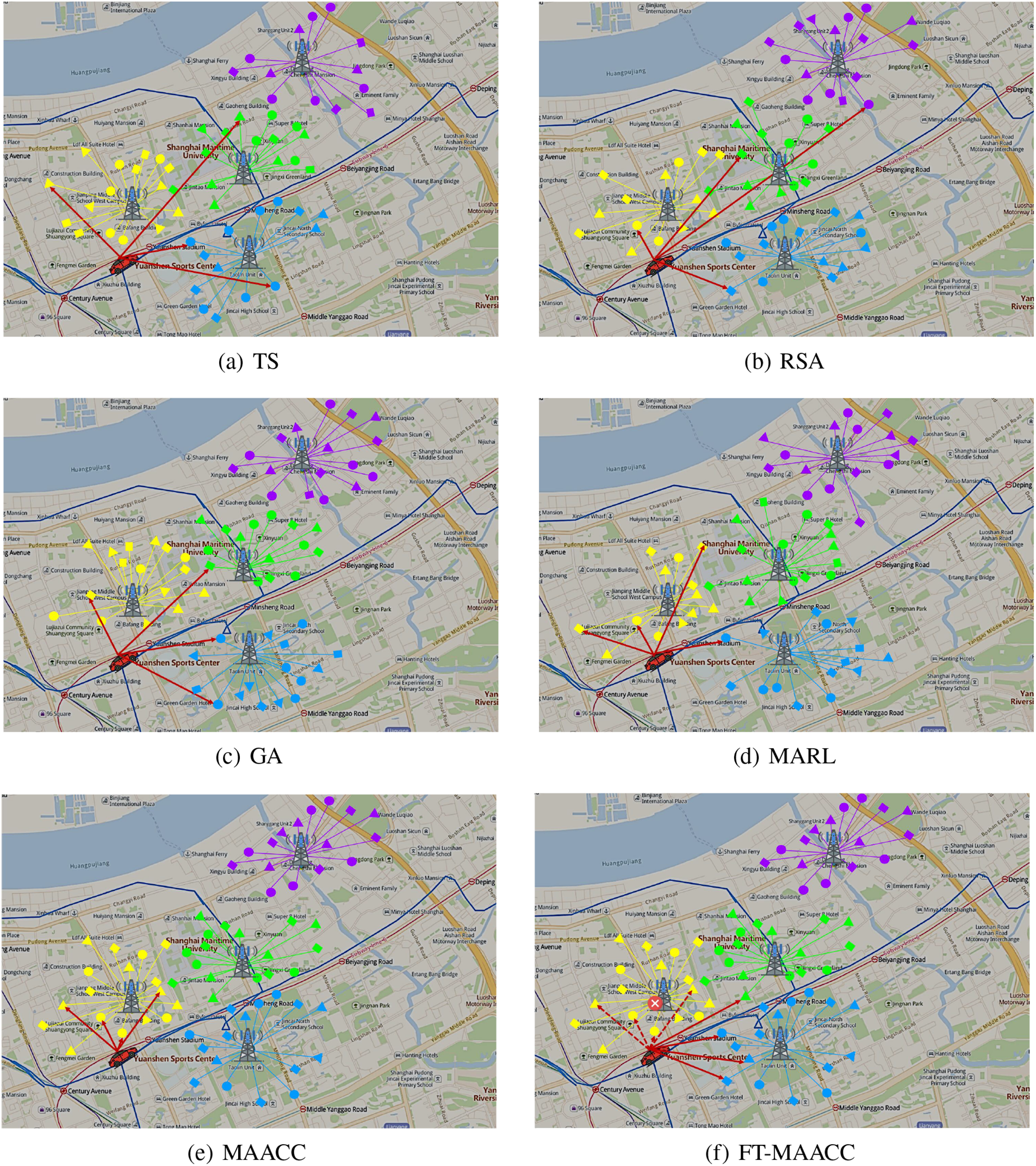
Figure 5: Cached resources using different algorithms
Fig. 6 shows the cache hit rates under various caching strategies and cache capacities in a fault-free base station scenario. As the capacity of the edge server increases, the cache hit ratio is observed to increase. By increasing the cache capacity of the edge server, the number of cached resources also increases. Consequently, mobile users are more likely to retrieve resources from local and adjacent edge servers, enhancing overall resource availability and accessibility. This results in a higher hit ratio. Since
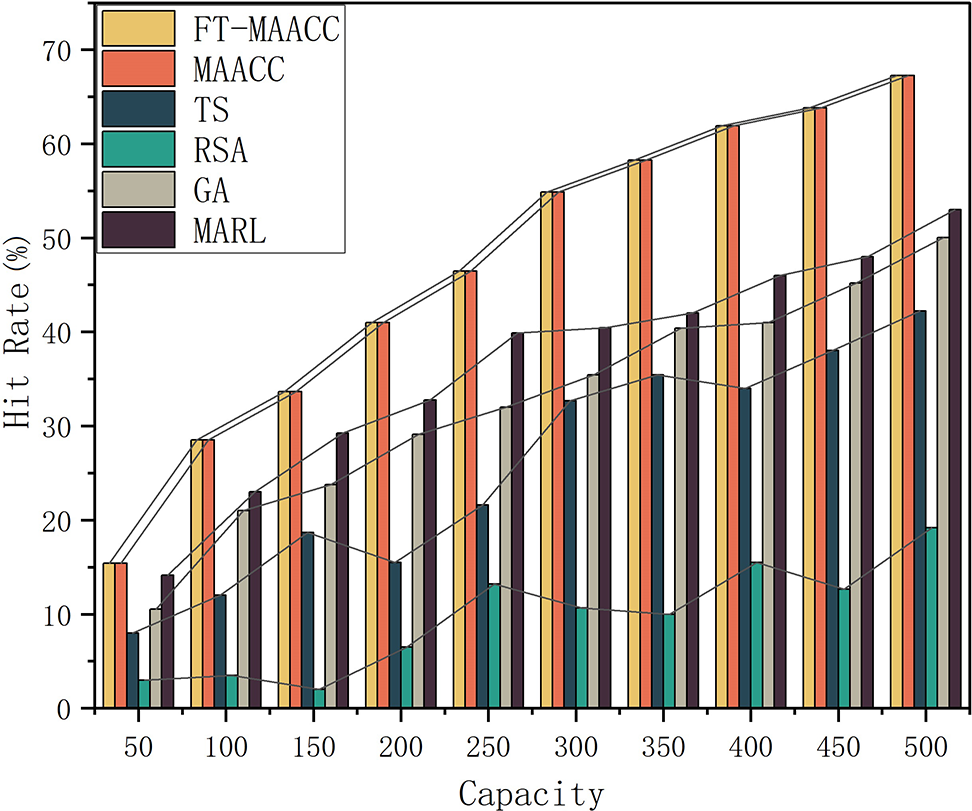
Figure 6: Cache hit rates of FT-MAACC/MAACC/TS/RSA/GA/MARL under different cache capacities (Absence of Failures)
Fig. 7 showcases the cache hit rate considering different cache capacities, various cache policies, and the occurrence of a random node failure. By incorporating fault tolerance mechanisms,
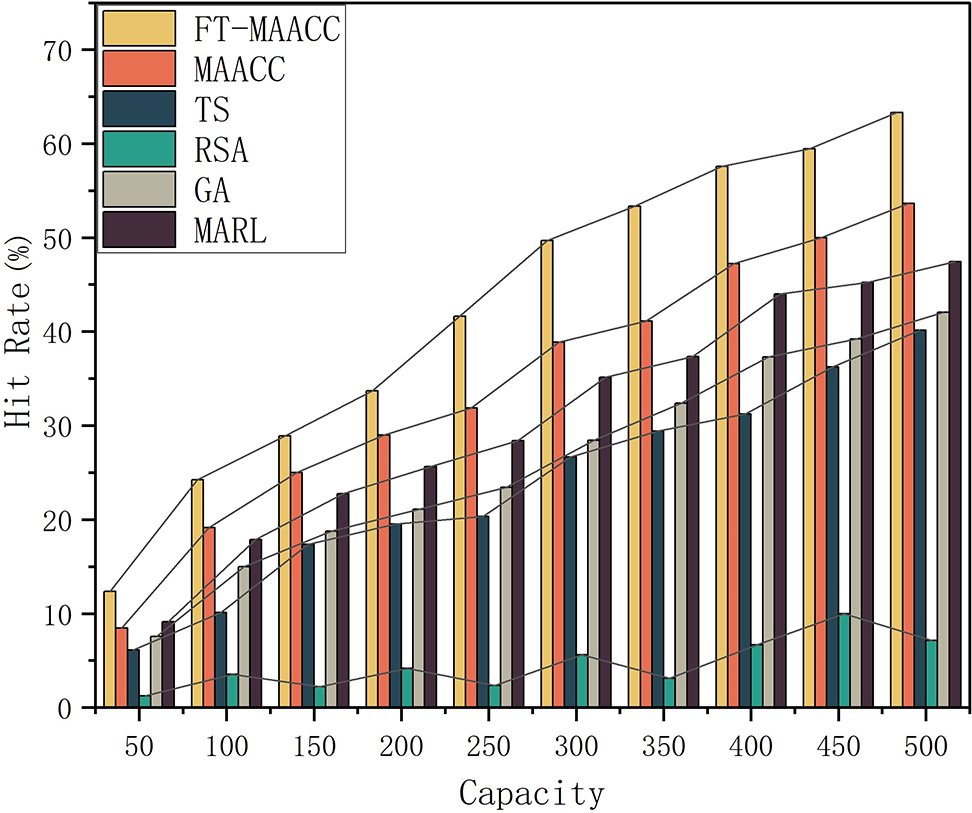
Figure 7: Cache hit rates of FT-MAACC/MAACC/TS/RSA/GA/MARL under different cache capacities (Presence of Failures)
Fig. 8 reveals the request latency with different caching strategies under different cache capacities in the scenario where the base station is fault-free. An increase in the cache capacity of an edge server leads to a decrease in resource transfer latency for all cache strategies. This observation suggests a direct relationship between cache capacity and the reduction of latency in resource transfers. This is because the larger the cache capacity, the higher the cache hit ratio of the edge server, the higher the possibility of mobile users obtaining resources from the local and neighboring servers, and the lower the corresponding resource transmission delay. Based on Fig. 8, it is evident that both
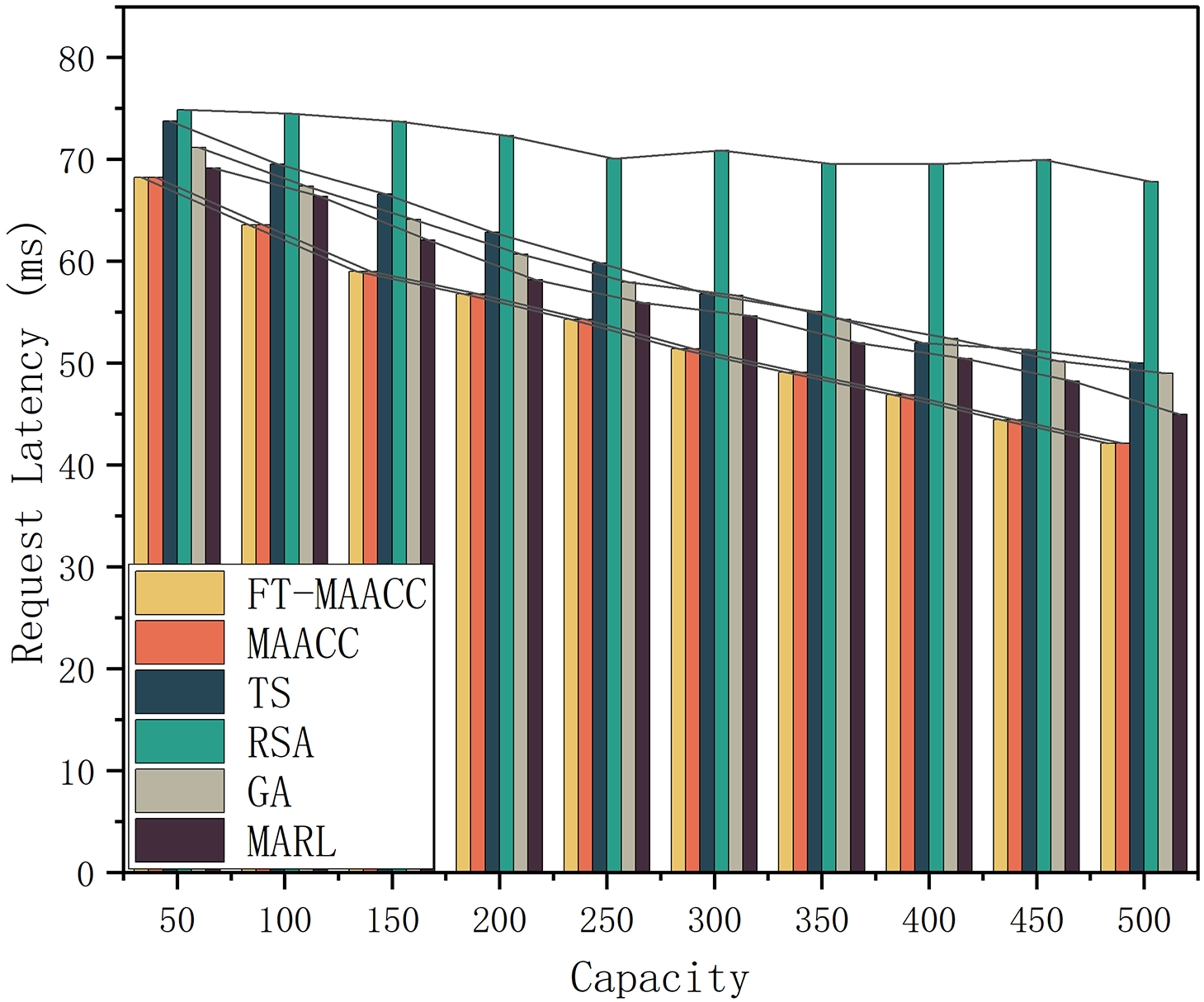
Figure 8: Request latency of FT-MAACC/MAACC/TS/RSA/GA/MARL under different cache capacities (Absence of Failures)
Fig. 9 depicts the request latency in the scenario where a random node failure occurs, considering different cache capacities and cache policies. When an edge node experiences a failure, the access latency for users to that node increases. Among the evaluated strategies,
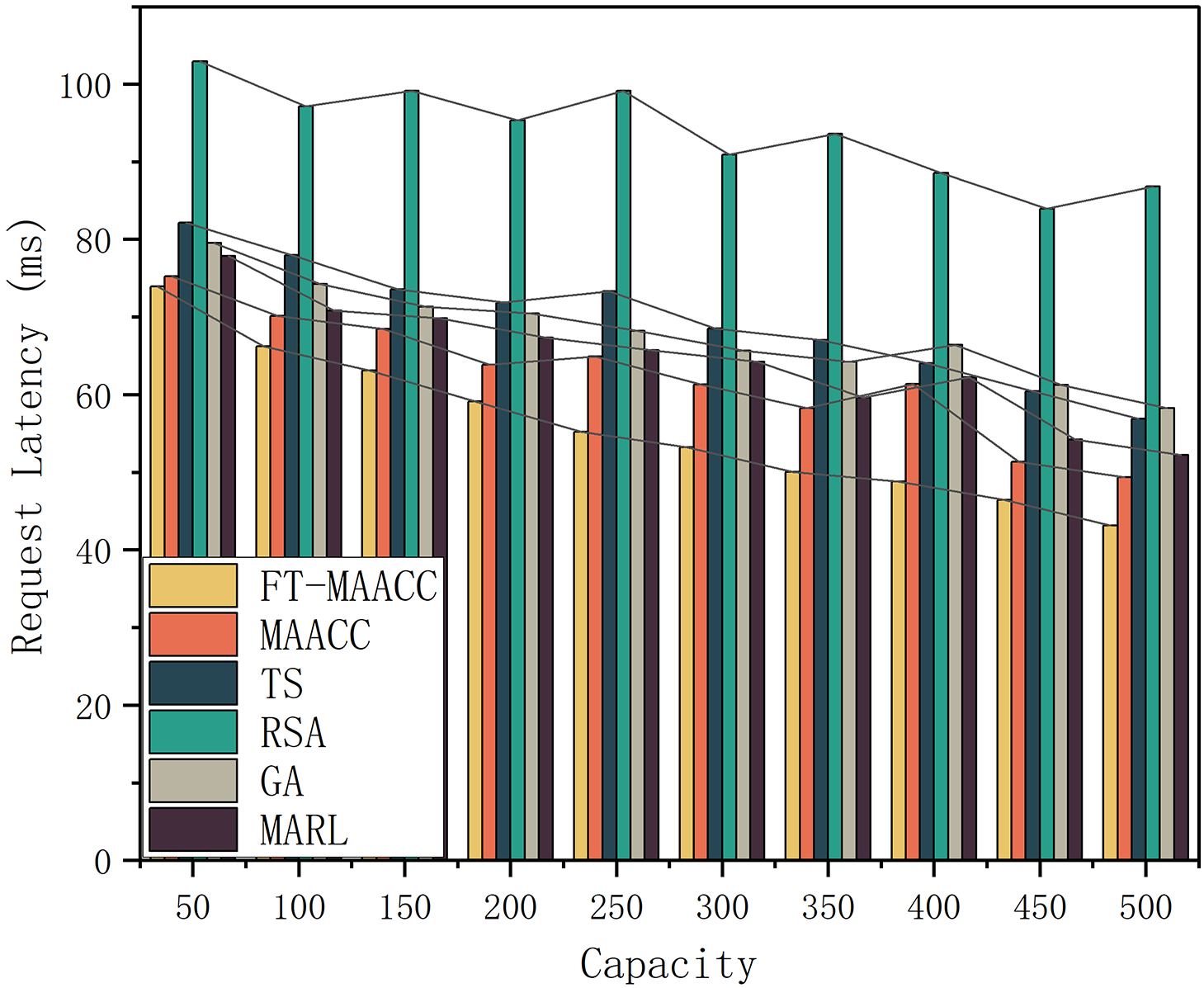
Figure 9: Request latency of FT-MAACC/MAACC/TS/RSA/GA/MARL under different cache capacities (Presence of Failures)
This article primarily addresses the challenge of high-speed mobile resource caching in the MEC environment and introduces a mobile-aware caching approach based on multi-agent deep reinforcement learning with fault tolerance (FT-MAACC). The strength of this approach lies in the agents’ capacity to adapt flexibly to changing conditions and real-time feedback, autonomously updating their behaviors and strategies to suit new contexts, thus providing higher-quality decision-making and services. Experimental results illustrate the effectiveness of this approach in enhancing cache hit rates and reducing content transmission latency.
In future research and development, we plan to further fortify the reliability and fault tolerance of edge computing cache systems. By introducing more robust fault detection and recovery mechanisms, we aim to ensure the system can promptly identify and respond to potential faults in edge nodes or the network. Through real-time monitoring of node availability and load conditions, our system will be capable of automatically switching to backup nodes to ensure the continuity and high availability of cache services. This approach will help address unforeseen failures, enhance system stability, and meet the ever-growing user demands.
Acknowledgement: The authors extend their appreciation to the reviewers for their valuable feedback, which enhanced the paper’s quality. Gratitude is also expressed to the editor for their guidance during the publication process. Their contributions have greatly contributed to the paper’s improvement.
Funding Statement: This article is supported by the Innovation Fund Project of Jiangxi Normal University (YJS2022065) and the Domestic Visiting Program of Jiangxi Normal University.
Author Contributions: The authors confirm contribution to the paper as follows: study conception and design: Yong Ma, Han Zhao, Yunni Xia; data collection: Kunyin Guo, Xu Wang; analysis and interpretation of results: Yong Ma, Han Zhao; draft manuscript preparation: Yong Ma, Han Zhao, Yunni Xia, Xu Wang; manuscript review and editing: Yunni Xia, Xianhua Niu, Dongge Zhu, Yumin Dong. All authors reviewed the results and approved the final version of the manuscript.
Availability of Data and Materials: The datasets employed in this research are openly accessible. The MovieLens dataset is thoroughly documented in [32], and its accessibility is outlined in the same source. As for the Shanghai Telecom dataset, it is comprehensively explicated in [31], and information regarding its acquisition can be found in the corresponding publication. These two datasets have been utilized in strict adherence to their individual usage guidelines and terms of service.
Conflicts of Interest: The authors declare that they have no conflicts of interest to report regarding the present study.
References
1. Wang, X., Han, Y., Wang, C., Zhao, Q., Chen, X. et al. (2019). In-Edge AI: Intelligentizing mobile edge computing, caching and communication by federated learning. IEEE Network, 33(5), 156–165. [Google Scholar]
2. Yao, J., Han, T., Ansari, N. (2019). On mobile edge caching. IEEE Communications Surveys & Tutorials, 21(3), 2525–2553. [Google Scholar]
3. Gao, H., Liu, C., Li, Y., Yang, X. (2021). V2VR: Reliable hybrid-network-oriented V2V data transmission and routing considering RSUs and connectivity probability. IEEE Transactions on Intelligent Transportation Systems, 22(6), 3533–3546. [Google Scholar]
4. Huang, M., Jiang, Q., Qu, Q., Rasool, A. (2021). An overlapping community detection approach in ego-splitting networks using symmetric nonnegative matrix factorization. Symmetry, 13(5), 869. [Google Scholar]
5. Reiss-Mirzaei, M., Ghobaei-Arani, M., Esmaeili, L. (2023). A review on the edge caching mechanisms in the mobile edge computing: A social-aware perspective. Internet of Things, 22, 100690. [Google Scholar]
6. Zhang, K., Leng, S., He, Y., Maharjan, S., Zhang, Y. (2018). Cooperative content caching in 5G networks with mobile edge computing. IEEE Wireless Communications, 25(3), 80–87. [Google Scholar]
7. Ndikumana, A., Ullah, S., LeAnh, T., Tran, N. H., Hong, C. S. (2017). Collaborative cache allocation and computation offloading in mobile edge computing. 2017 19th Asia-Pacific Network Operations and Management Symposium (APNOMS), Seoul, Korea (SouthIEEE. [Google Scholar]
8. Tang, Y., Guo, K., Ma, J., Shen, Y., Chi, T. (2019). A smart caching mechanism for mobile multimedia in information centric networking with edge computing. Future Generation Computer Systems, 91, 590–600. [Google Scholar]
9. Wu, Q., Zhao, Y., Fan, Q., Fan, P., Wang, J. et al. (2022). Mobility-aware cooperative caching in vehicular edge computing based on asynchronous federated and deep reinforcement learning. IEEE Journal of Selected Topics in Signal Processing, 17(1), 66–81. [Google Scholar]
10. Wei, H., Luo, H., Sun, Y. (2020). Mobility-aware service caching in mobile edge computing for internet of things. Sensors, 20(3), 610. [Google Scholar] [PubMed]
11. Sadeghi, A., Sheikholeslami, F., Giannakis, G. B. (2017). Optimal and scalable caching for 5G using reinforcement learning of space-time popularities. IEEE Journal of Selected Topics in Signal Processing, 12(1), 180–190. [Google Scholar]
12. Jiang, W., Feng, G., Qin, S., Liang, Y. C. (2019). Learning-based cooperative content caching policy for mobile edge computing. ICC 2019–2019 IEEE International Conference on Communications (ICC), Shanghai, China, IEEE. [Google Scholar]
13. Ostrowski, K., Małecki, K., Dziurzański, P., Singh, A. K. (2023). Mobility-aware fog computing in dynamic networks with mobile nodes: A survey. Journal of Network and Computer Applications, 219, 103724. [Google Scholar]
14. Zhong, C., Gursoy, M. C., Velipasalar, S. (2020). Deep reinforcement learning-based edge caching in wireless networks. IEEE Transactions on Cognitive Communications and Networking, 6(1), 48–61. [Google Scholar]
15. Song, J., Sheng, M., Quek, T. Q., Xu, C., Wang, X. (2017). Learning-based content caching and sharing for wireless networks. IEEE Transactions on Communications, 65(10), 4309–4324. [Google Scholar]
16. Zhang, F., Ge, J., Wong, C., Li, C., Chen, X. et al. (2019). Online learning offloading framework for heterogeneous mobile edge computing system. Journal of Parallel and Distributed Computing, 128, 167–183. [Google Scholar]
17. Sun, H., Yu, H., Fan, G., Chen, L. (2020). Qos-aware task placement with fault-tolerance in the edge-cloud. IEEE Access, 8, 77987–78003. [Google Scholar]
18. Mitsis, G., Tsiropoulou, E. E., Papavassiliou, S. (2022). Price and risk awareness for data offloading decision-making in edge computing systems. IEEE Systems Journal, 16(4), 6546–6557. [Google Scholar]
19. Zhang, Y., Niu, W., Yan, L. (2024). Irs assisted uav communications against proactive eavesdropping in mobile edge computing networks. Computer Modeling in Engineering & Sciences, 138(1), 885–902. https://doi.org/10.32604/cmes.2023.029234 [Google Scholar] [CrossRef]
20. Yun, S., Chen, Y. (2023). Intelligent traffic scheduling for mobile edge computing in iot via deep learning. Computer Modeling in Engineering & Sciences, 134(3), 1815–1835. https://doi.org/10.32604/cmes.2022.022797 [Google Scholar] [CrossRef]
21. Gao, H., Wang, X., Wei, W., Al-Dulaimi, A., Xu, Y. (2023). Com-DDPG: Task offloading based on multiagent reinforcement learning for information-communication-enhanced mobile edge computing in the internet of vehicles. IEEE Transactions on Vehicular Technology, 73(1), 348–361. [Google Scholar]
22. Acheampong, A., Zhang, Y., Xu, X., Kumah, D. A. (2023). A review of the current task offloading algorithms, strategies and approach in edge computing systems. Computer Modeling in Engineering & Sciences, 134(1), 35–88. https://doi.org/10.32604/cmes.2022.021394 [Google Scholar] [CrossRef]
23. Xue, Z., Liu, C., Liao, C., Han, G., Sheng, Z. (2023). Joint service caching and computation offloading scheme based on deep reinforcement learning in vehicular edge computing systems. IEEE Transactions on Vehicular Technology, 72(5), 6709–6722. [Google Scholar]
24. Ghosh, S., Agrawal, D. P. (2021). A high performance hierarchical caching framework for mobile edge computing environments. 2021 IEEE Wireless Communications and Networking Conference (WCNC), Nanjing, China, IEEE. [Google Scholar]
25. Zhao, J., Ma, Y., Xia, Y., Dai, M., Chen, P. et al. (2022). A novel fault-tolerant approach for dynamic redundant path selection service migration in vehicular edge computing. Applied Sciences, 12(19), 9987. [Google Scholar]
26. Zheng, C., Liu, S., Huang, Y., Zhang, W., Yang, L. (2022). Unsupervised recurrent federated learning for edge popularity prediction in privacy-preserving mobile-edge computing networks. IEEE Internet of Things Journal, 9(23), 24328–24345. [Google Scholar]
27. Peng, X., Han, Z., Xie, W., Yu, C., Zhu, P. et al. (2022). Deep reinforcement learning for shared offloading strategy in vehicle edge computing. IEEE Systems Journal, 17(2), 2089–2100. [Google Scholar]
28. Hazarika, B., Singh, K., Li, C. P., Biswas, S. (2022). Multi-agent DRL-based computation offloading in multiple RIS-aided IoV networks. MILCOM 2022–2022 IEEE Military Communications Conference (MILCOM), Rockville, MD, USA, IEEE. [Google Scholar]
29. Xiao, Y., Wan, K., Xiao, L., Yang, H. (2022). Energy-efficient collaborative inference in mec: A multi-agent reinforcement learning based approach. 2022 8th International Conference on Big Data Computing and Communications (BigCom), Xiamen, China, IEEE. [Google Scholar]
30. AlDurgam, M. M., Duffuaa, S. O. (2010). Optimal maintenance policies for three-states pomdp with quality measurement errors. 2010 IEEE International Conference on Industrial Engineering and Engineering Management, Macao, China, IEEE. [Google Scholar]
31. Liu, S., Liu, Y., Ni, L. M., Fan, J., Li, M. (2010). Towards mobility-based clustering. Proceedings of the 16th ACM SIGKDD International Conference on Knowledge Discovery and Data Mining, Washington DC, USA. [Google Scholar]
32. Harper, F. M., Konstan, J. A. (2015). The movielens datasets: History and context. ACM Transactions on Interactive Intelligent Systems, 5(4), 1–19. [Google Scholar]
33. Xiao, H., Zhao, J., Pei, Q., Feng, J., Liu, L. et al. (2021). Vehicle selection and resource optimization for federated learning in vehicular edge computing. IEEE Transactions on Intelligent Transportation Systems, 23(8), 11073–11087. [Google Scholar]
34. Banerjee, B., Kulkarni, A., Seetharam, A. (2018). Greedy caching: An optimized content placement strategy for information-centric networks. Computer Networks, 140, 78–91. [Google Scholar]
35. Xu, X., Chen, P., Xia, Y., Long, M., Peng, Q. et al. (2022). MROCO: A novel approach to structured application scheduling with a hybrid vehicular cloud-edge environment. 2022 IEEE International Conference on Services Computing (SCC), Barcelona, Spain, IEEE. [Google Scholar]
Cite This Article
 Copyright © 2024 The Author(s). Published by Tech Science Press.
Copyright © 2024 The Author(s). Published by Tech Science Press.This work is licensed under a Creative Commons Attribution 4.0 International License , which permits unrestricted use, distribution, and reproduction in any medium, provided the original work is properly cited.


 Submit a Paper
Submit a Paper Propose a Special lssue
Propose a Special lssue View Full Text
View Full Text Download PDF
Download PDF Downloads
Downloads
 Citation Tools
Citation Tools